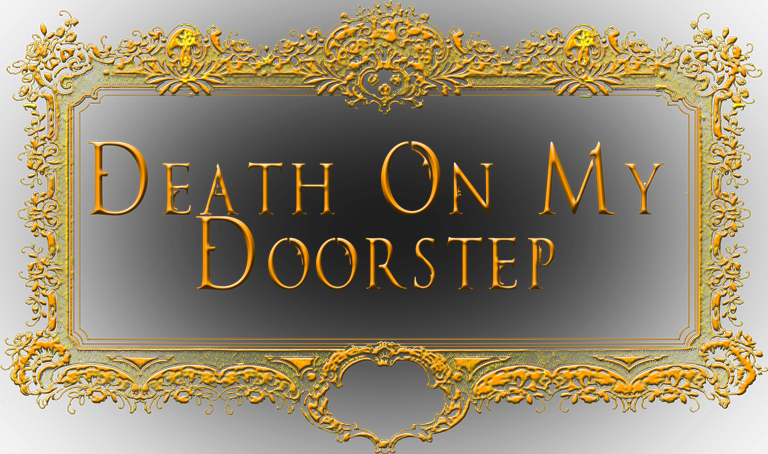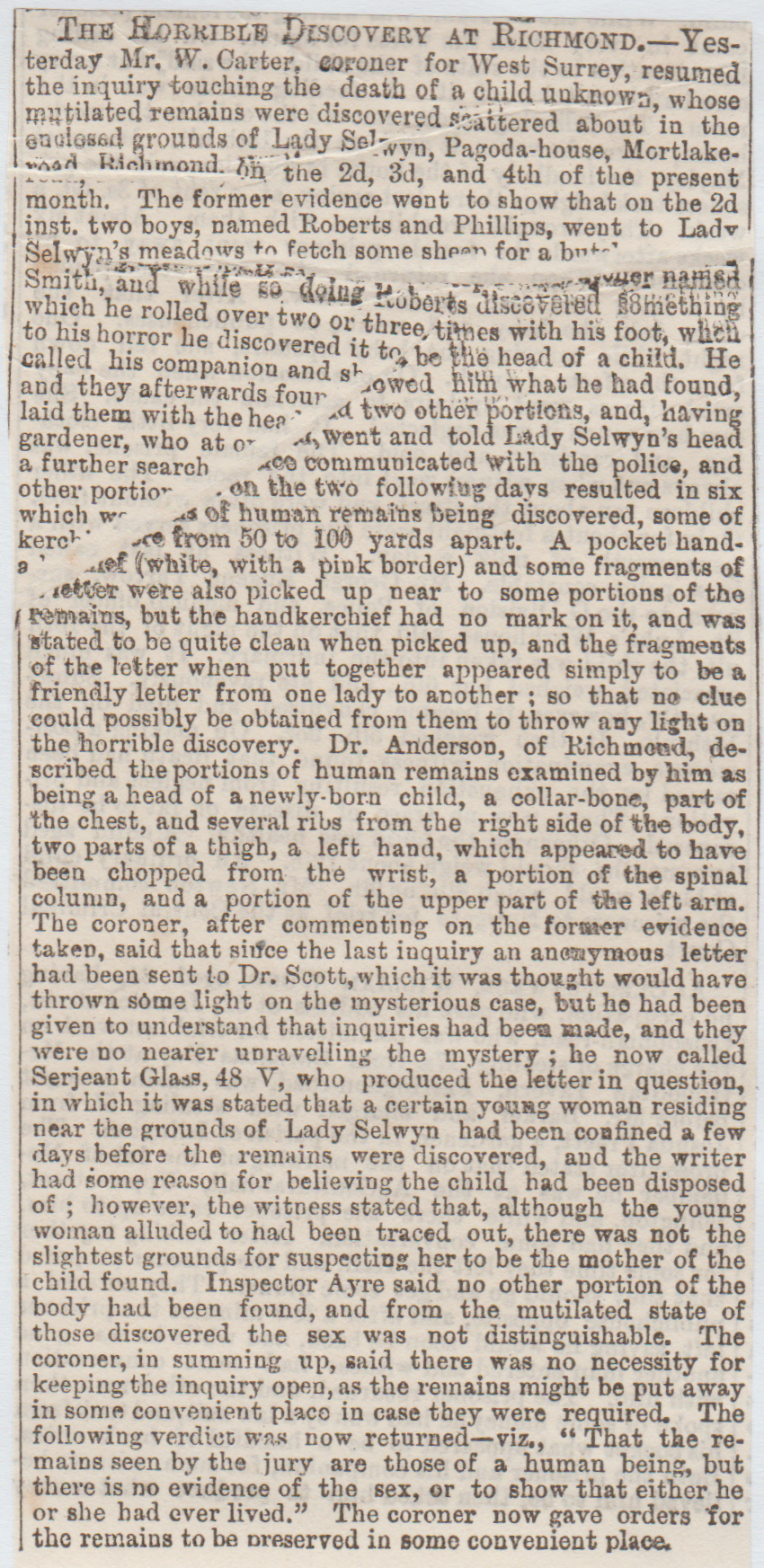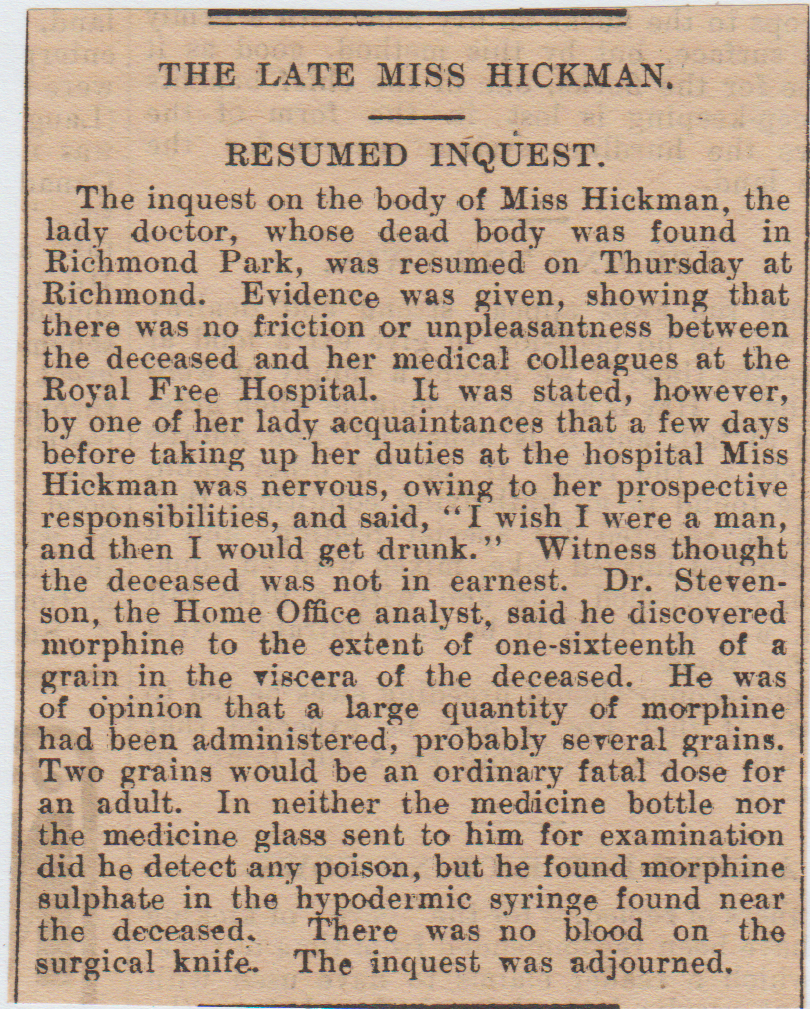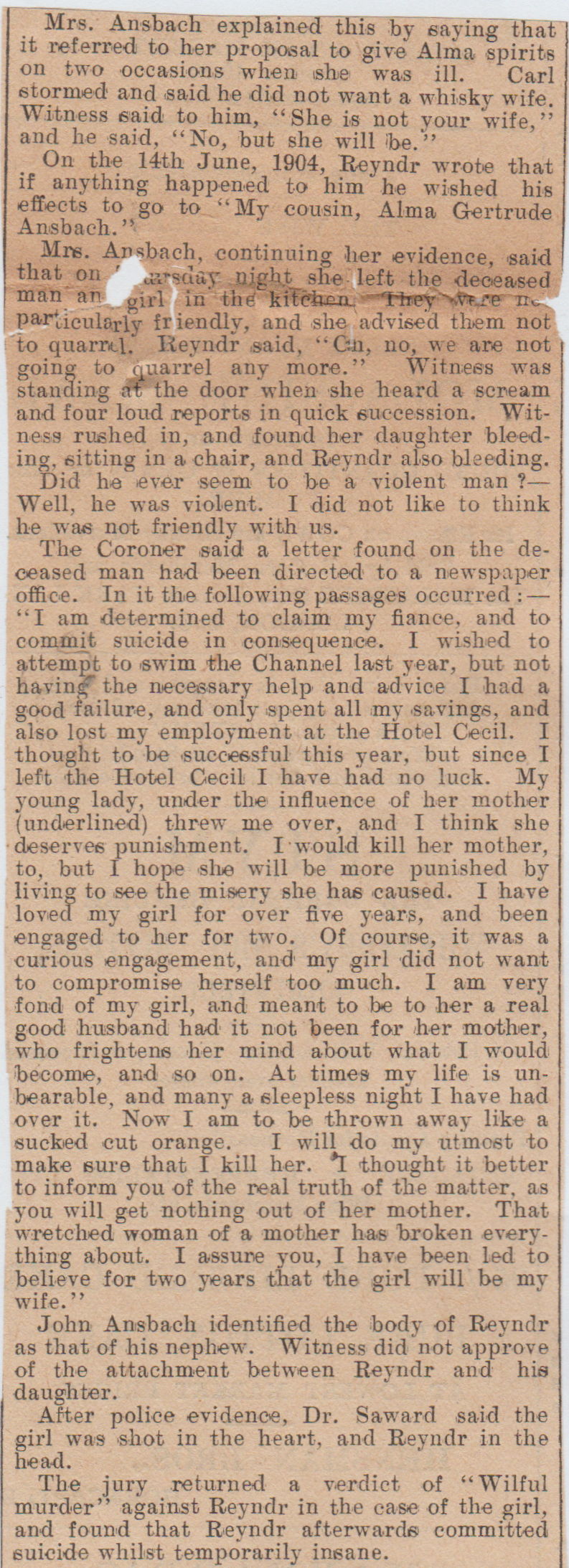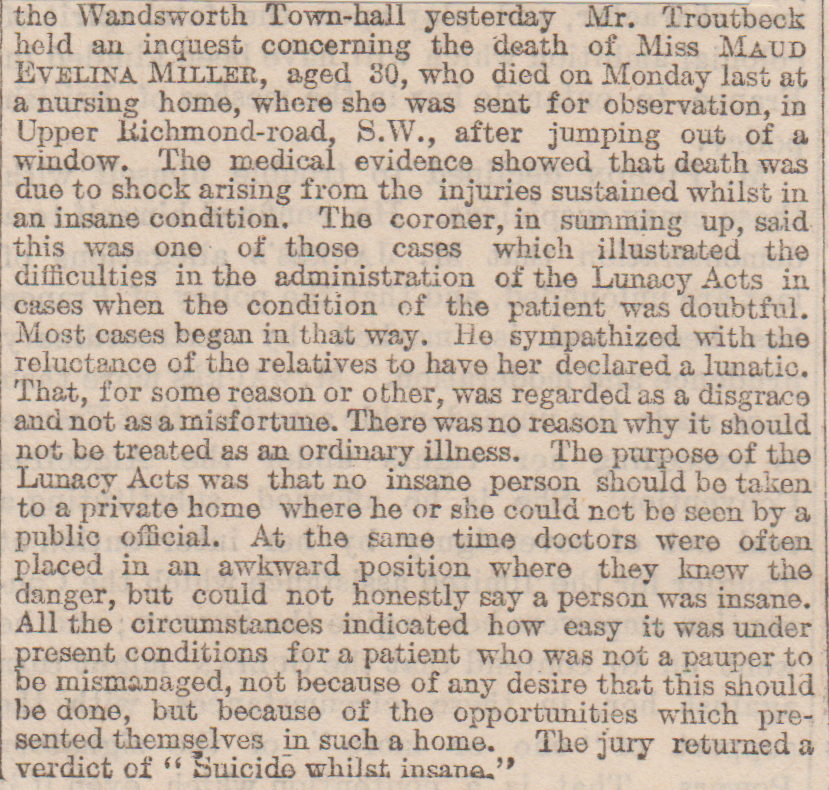1/ Girl’s Body Found in Ilford, Redbridge, March 1899
The body of a young girl which was badly mutilated was found in a cupboard of an empty house. The child had been missing for a number of days and a £10 reward was offered for its return. A watchman found her while doing his rounds, and the body was taken to Forest Gate mortuary. So far the perpetrator of this crime has not been found.
FURTHER NEWS
The little girl, Bertha Russ, went missing from East Ham a couple of weeks ago. She had been dead for a few days and police think she was put there at a later date than the day she went missing. The strange thing is that the house had been searched a few days’ previously but no sign was spotted then.
2/ Wanstead Flats, Redbridge, May 1908 (Romantic Suicide)
Mr. William Alsworth of Romford Road, Manor Park, was walking past the lake on Wanstead Flats (built by East Ham’s unemployed) when he noticed a pile of women’s clothes. He found a policeman who summoned a team to drag the lake. They recovered the bodies of a man and a woman both locked in each other’s arms, and both in their mid-twenties. Inside his pocket was a pawn-ticket from Mile-End which pledged a coat, and small change. Two soggy bus ticket’s from Manor Park to Stratford Broadway were also on his person. A romantic touch was the letter on her person which began “My Darling Sweetheart” and ended with “Your loving sweetheart”. (Who were they?)
3/ Fatal Accident at Twickenham Railway Station, Richmond-upon-Thames. August 1889
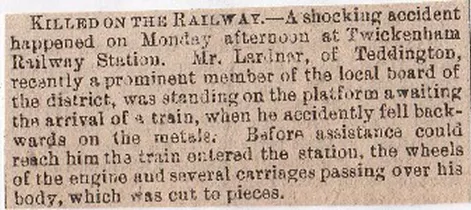
4/ Wanstead Park, Redbridge, July 1889 (Cricket Death)

5/ Ham, Surrey, Richmond-upon-Thames, June 1953
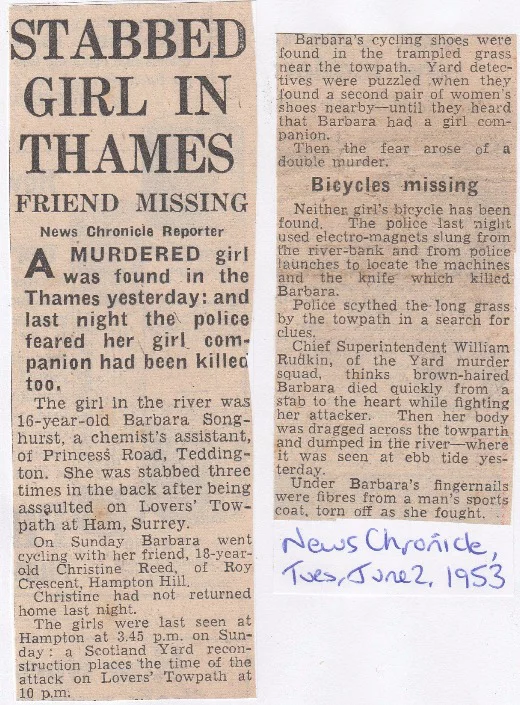
6/ Richmond, Surrey, August 1849 (Suicide in Police Cell)
An inquest was held at the Marquis of Granby public-house, Richmond,(still there-on Sheen Street) on the body of Joseph T.Wheeler. The 40-year-old Wheeler was locked up for nicking a washtub and towel. The next morning a warder went to wake him up and saw him hanging by his braces from cell bar. A suicide note was left, and in it, he stated that being unemployed for so long had led him to steal so he killed himself. Verdict “Temporary Insanity”.
7/ Richmond Cemetery Suicide, October 1918
Samuel Bridge, aged 60, of Larkhall Rise, Clapham, decided to end it all on his wife’s grave at Richmond Cemetery. He shot himself in the mouth and left the following letter:-
“I have spent some lovely hours in Richmond, dear old Richmond, and I am now sitting on my wife’s grave in God’s beautiful sunshine and feel quite at rest, but quite tired and weary. I am played out, and always since I was about 25 years or so knew that I should commit this at some time”. A verdict of “Suicide during temporary insanity”.(Is his wife’s grave still there?)
8/ Kingston-upon-Thames Drowning, June 1899
A young man named Crane, employed at Kelly’s Printing Works, Kingston-on-Thames, was drowned yesterday morning while bathing in the Thames.
9/ Hampton Court Palace Suicide, January 1834
A domestic servant who worked at Hampton Court Palace killed himself last week. The victim was a footman to Lady Emily Montague (Palace house-keeper), who slit his throat in one her carriages. He was discovered sitting bolt upright having nearly decapitated himself.
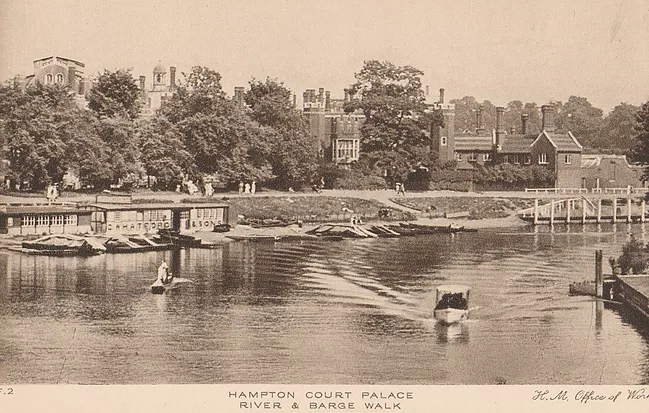
10/ Hampton Court Palace, November 1871 (Skeletons Discovered)
There has been excavation and building work going on at Hampton Court Palace, and while digging up the pavement in one of the old courts’ workmen discovered two skeletons. They are both male and estimates suggest that they have been buried for around 200 years. The section where they were found was improved and rebuilt by Sir Christopher Wren in 1690, so if they’d have been in their present resting place they would have been disturbed at that time. After this Wren rebuild, William the Third and Mary used this Palace and it is well-known that King William met with the accident that caused his death at Hampton Court in 1702. So chances are that the skeletons are from around that period. (Where were they buried after this episode?)
11/ Richmond-upon-Thames (Infants Body) October 1880
A headless corpse of an infant was found in a box of a domestic servant named Elizabeth Greenwood, at number 6, Cardigan Road. An officer from Kent Constabulary produced the child’s head at the inquest, which was discovered in a kitchen grate of a house in Herne Bay in that county. Greenwood had been a lodger at this home in Herne Bay and she was arrested on the charge of concealment of birth. She admitted to beheading the child straight after giving birth to it, with a table knife which was in the kitchen. The knife was found in a W.C. on the same property.

12/ Hampton Court Fatality, August 1840
Queen Victoria and Prince Albert, along with the Earl of Albemarle and Mrs Paget, Maid of Honour, arrived at Hampton Court. They came from the Earl of Albemarle’s residence, Home Park. While climbing out of the carriage three workmen who were working on the roof, leaned over to catch a glimpse of Her Majesty and one overbalanced and fell sixty feet onto the pavement. He landed a couple of yards from Prince Albert and apparently, Queen Victoria was hysterical. The workman died on the spot.
13/ Hampton Court Palace, Royal Gardens, July 1898
While workmen were employed in demolishing a wall in the Royal Gardens it collapsed and fell with a crash, onto a man named John Fuller aged thirty. He was extricated from the rubble but was pronounced dead by a doctor. The wall was fourteen feet high.
14/ Kew Suicide, June 1852
Edward Tolfree, an eighteen-year-old of weak intellect, killed himself by an unusual method at Kew. He set fire to a stable then threw himself on top of it.
15/ Barnes, (Thames River) April 1892
Two young men named Mackey and Davey, aged twenty-five and twenty-seven respectively, were drowned in the Thames at Barnes on Saturday night by the upsetting of an outrigger. Three other occupants of the boat had a narrow escape. The deceased were both unmarried.
16/ Kew Bridge, August 1889

17/ Richmond-upon-Thames, November 1870 (Human Remains)
A twelve-year-old shepherd named Oliver Wilson was gathering a flock of sheep at Lady Selwyn’s park at Richmond when he fell under the wall and landed on a baby’s head. A further search near an elm tree brought the ribs and a portion of the neck. More human remains were discovered over the next couple of days.
18/ Twickenham, February 1899
The naked body of a middle-aged woman was found in the River Crane. The body was identified as that of Sarah Penfold, the wife of a District Council employee, living in Colne Road. The corpse had severe bruising on her face and head.
19/ Richmond-upon-Thames, July 1871
The landlord of the Red Lion at Old Brentford, Joseph Banks, was found by a lamp-lighter hanging by a rope from an attic window at the Star and Garter in Richmond, the residence of his father. The rope was tied around the legs of a large table which was in the bedroom. (Is either pub still there?)
20/ Richmond, (M.P. Shooting) March 1890

21/ Richmond Station Suicide, April 1903
An inquest into the suicide of trooper Edward Smith, 1st Dragoon Guards, whose body was found decapitated near Richmond Station on the eve of his wedding. On Saturday evening on Richmond Bridge, he left his bride-to-be, who had just her wedding dress, saying that he was off to get his helmet and sword. The bridegroom’s mother only heard about her son’s death when she turned up to the wedding on Sunday. He was in a kneeling position when the train struck him and this could have been about the fact that he had taken a comrades jewellery and a medal.
22/ Coniston Road Corpse, Twickenham, November 1891
A woman in her mid-twenties was found in an unfinished house in Coniston Road, Twickenham, badly decomposed and partially dressed. Death was estimated at 6-7 months ago, and she had some of the clothes removed and her hands were in a clenched position. (Who was she?)
23/ Avenue House, Richmond Green, July 1870 (Butler’s Suicide)
The body of Richard Robson aged 58, who was a butler to Mrs Cahill of Richmond Green, was discovered in a water-tank at Avenue House. He was last seen alive at 10-30 a.m. on Saturday and twenty minutes later he was found drowned. He became very down in the dumps when his master died a few months ago and never really got over it.
24/ Barnes Green Fatal Accident, May 1899

25/ Barnes, November 1833 (Nervous Suicide)
Miss Mary Watt had just had a game of chess with her father and retired to bed at eleven o’clock, then after a few minutes, a shrill scream was heard coming from her room. The parents ran upstairs and when they got in the room she said: “There’s a wretch behind the door with a razor going to murder me”. Sure enough, Mr Watt found Mr Dumas, the French assistant, stood there with a razor. He said nothing when arrested. Miss Watt, on the other hand, took a draught of Eau de Cologne fell into a fit and died the next morning. Eau de Cologne means to me, the cheap crappy after-shave we give to the men in our family at Christmas, but the Victorian drank the bloody stuff! The inquest of her death said she died from “drinking Eau de Cologne, being under a degree of nervous excitement at the time”. Dumas was held in custody and went to the Crown Inn, Croydon, where he went to bed. The next morning the door was forced open due to him not answering, and he was discovered with razor marks on his arms, and he had also taken some laudanum just to make sure. He pulled through and was sent to his mates in London to recuperate but there he ripped off the bandages and tore open the gashes to try and kill himself again. He was prevented again from doing so but tells everyone he is determined to kill himself.
26/ Hampton Waterworks/River Thames, March 1874 ( Suicide)
18-year-old Charles Hampton was a parcels porter at Staines Railway Station and he left work on January 23rd and didn’t go back. Over a month later his body was fished out of the Thames by a lighter-man. His parents got a letter dated the 22nd January from Staines, in it he said: “I have been so ill recently, I don’t know what to do with myself. I am half afraid I am mad. I feel so ill sometimes that I am afraid of myself, and am obliged to go away from my office or house and plunge into company. My wages have been so low that I have never been able to get a dinner more than once a week, and that and wet feet have brought me so low that I don’t care to live any longer.” He then mentions about somebody robbing his till as an act of revenge, and this also contributed to his suicide. He also said:- “Give my love to all my brothers and sisters and never let another work on a railway. I only wish I could die a natural death and not by my own hand. I do hope you will not feel this much, as I feel quite prepared to die. I have thought of this for months and have been stopped once by a kind friend in Richmond, but it is no good. I feel all my sins are forgiven in heaven; I hope they will be on earth.”. The jury commented on his small wages of only 13 shillings a week and said it was inadequate.
27/ Wanstead Park Double Suicide, Redbridge, March 1898
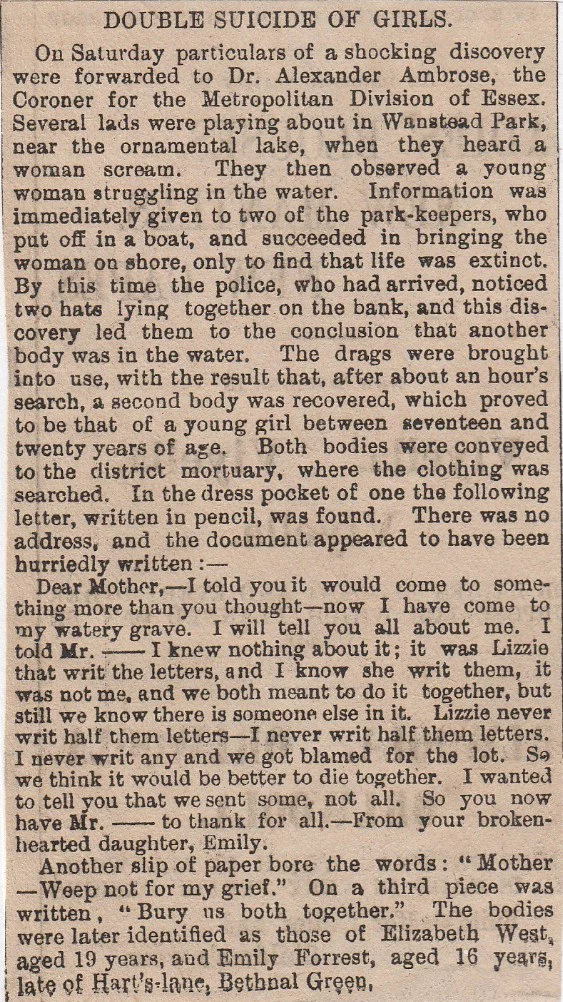
28/ Richmond Murder? May 1859
Mr Smethurst, a surgeon residing at Richmond, was up before magistrates at Richmond Police Court, charged with causing the death of a woman with whom he was living by administering poison supposed to be arsenic, to her. The deceased had some property which the prisoner was aware of, and some arrangements had been desired to be made for the disposal of a portion. However, a short time ago, she became ill and was attended by Dr’s Julius and Bird of Richmond, who administered the proper medicine for the disease from which she was suffering. All their attention and medicine acted quite contrary to the desired effect, when, on Monday she became so ill that suspicions were excited and police were called in. The deceased expired on Tuesday morning and the medical gentlemen’s opinion was that she had been poisoned. Traces of arsenic were found but not sufficient enough. The contents of the stomach were yet to be analysed.
29/ Richmond/River Thames, March 1905 (Body Found)
The lifeless body of a lady patient who mysteriously disappeared from the residence of Mr Thomas Chant of East Twickenham was found on Friday in the Thames at Richmond. They have been identified as the daughter of Mr Horace Smith, one of the London magistrates. She was an artist of considerable talent but overstudy had brought about her mental trouble.
30/ Richmond Murder/Suicide, September 1906
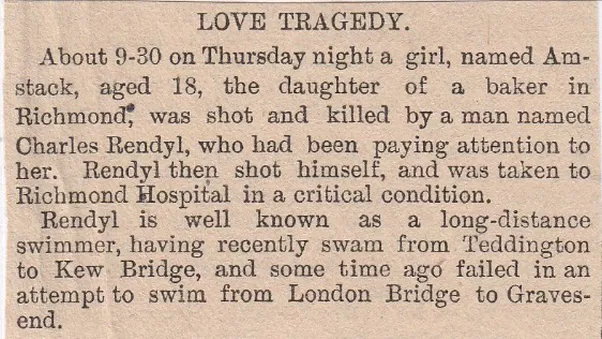
31/ Richmond Park Fatal Accident August 1870
32/ Child Remains at Pagoda House, Mortlake Rd, Richmond. November 1870 (Mis-print/ Paper folded when printed)
33/ Decomposed Remains Found in Richmond Park, October 24th, 1903. (Miss Sophia Frances Hickman)
Saturday, October 31st, 1903. Missing Tabloids and Syringe.
The mystery surrounding the death of Miss Hickman has, in view of the latest discovery, become more complicated than ever. A medicine bottle with a dark-coloured sediment adhering to its interior was discovered in the plantation not far from where the deceased’s body lay; a surgeon’s scalpel was, a few days later, found outside the plantation fence, and now it has been ascertained that two days before her departure from the Royal Free Hospital she purchased a quantity of morphia tabloids. On the same occasion, Miss Hickman regained possession of a hypodermic syringe which was undergoing repairs. it may be that these will subsequently turn out to have had nothing to do with her death. On the other hand, they furnish evidence on a very important point, viz., that the deceased lady was in possession of a poison at the time she went away, and had the means, if she felt so disposed, of taking her own life.
Saturday, November 7th, 1903. (Resumed Inquest)
34/ Attempted Wife Murder, March 1904. (Annie Mortimer certainly is not good at choosing a good man!)
35/ Murder/Suicide at Salisbury Road, Richmond-on-Thames. September 1906
36/ Suicide in a Nursing Home, Upper Richmond Road, Barnes. December 1906
37/ Tragic Death at Strawberry Hill Station, Richmond. November 1880
38/ Death at Hampton Court Palace. October 1880
We have to record the death of Lady Gore, which occurred on Sunday at Hampton Court Palace. Her ladyship, who was in her 78th year, was Sarah Rachel, daughter of the late Hon. James Fraser, Legislative Councillor of Nova Scotia, and married, in 1824, General the Hon. Sir Charles Gore, G.C.B., and K.H. (sixth son of Arthur Saunders, second Earl of Arran), who died in 1869, and by whom she had three sons and two daughters. Her elder daughter is the Countess of Erroll.
